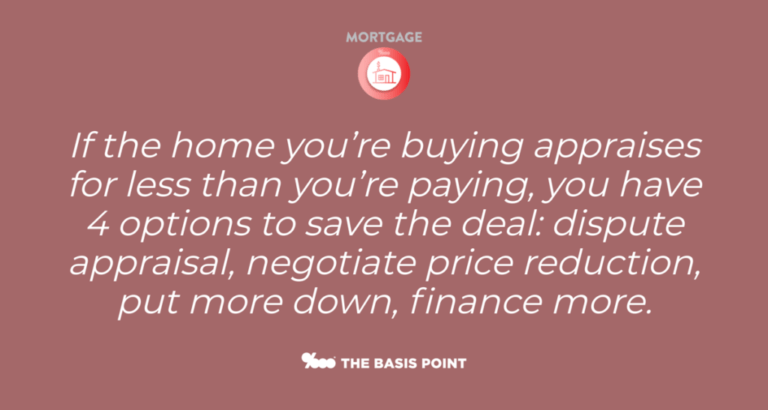What To Do When 1 in 8 Home Purchases Have A Low Appraisal

When you finance a home purchase, your lender will make the loan based on the lower of the home’s appraised value and your contract price. And right now, CoreLogic data says about 13% of appraisals (1 in every 8) are below purchase contract prices in America. So is your home purchase deal dead if your appraised value is below your purchase price? Not if you know and follow these 4 tips.
1. Dispute Your Low Appraisal
Getting a low appraisal is annoying, but a common factor in a hot market. Open market bidding should imply the market value of a home, and you can dispute appraisals to make this point.
This dispute process is called a rebuttal, and a successful rebuttal involves asking to correct characteristics about the property (square feet, bed/bath count, improvements, etc.) or submitting additional recent comparable sales that the appraisal didn’t include (which your realtor can help you get for your lender).
Home appraisals derive value by using comparable homes in nearby neighborhoods. And homes are compared using a long list of traits: bed/bath count, size, condition, upgrades, views, etc. A strong rebuttal must address discrepancies in these traits specifically.
Having lender submit an appraisal rebuttal doesn’t guarantee you’ll get the low appraisal revised. But a data-focused rebuttal is the only thing that’ll be taken seriously — opinions about homes and neighborhoods aren’t considered. You must ask your lender to explain how this process works in their firm.
Note that lenders must follow strict consumer protection regulations designed to prevent lenders from strong-arming appraisers on values. This means that regulations designed to help you can prevent your lender from pushing too hard on appraisal rebuttals.
2. Negotiate Price Reductions
If you get a low appraisal, it can also be used as strong, technical rationale to renegotiate your purchase price lower with your seller. Before you do this, make sure you know how many offers were made on the property other than yours.
Also find out whether any of those offers were cash offers. Why? Because cash offers don’t require appraisals, and sellers may move to accept a cash offer if challenged. Cash buyers will often get appraisals, but an appraisal is not required for them to close their deal. Sellers know this, so you need to know it too when renegotiating.
If you’re financing the home, you’re required to get an appraisal. Your lender will make your loan on the lower of the appraised value or contract price. But you can still choose to go forward if your appraisal comes in low. See the two sections below for how to do this. And if you choose not to go forward, you can use the appraisal contingency in your contract to exit the contract. Just make sure you write that appraisal contingency in before you present your offer!
3. Know This Mortgage Math Before You Write Offers
To give you a low appraisal example, let’s use a $500,000 home purchase price with 10% down — which is 90% financing.
This means your 10% down payment is $50,000.
If the low appraisal came in at $485,000, then your lender would lend you 90% of $485,000, not 90% of $500,000.
But your purchase price (assuming you couldn’t renegotiate a lower price) is still $500,000. So if you can only borrow 90% of $485,000, then your down payment needs to be $63,500 instead of $50,000.
This is extra $13,500 might be worth it to you because you believe the home is worth more, you’re going to be there for a long time, and you may have the money.
If you’re in a competitive market full of over-bidding, this can lead to low appraisals. As such, you’ll definitely want to know these scenarios in advance. Ask your lender to do a couple examples for you so you can determine if you have the cash — and if it’s worth it to you.
4. Can You Finance More After A Low Appraisal?
If you can’t or don’t want to bring in more cash, then you also need to have a conversation with your lender BEFORE writing offers.
Our scenario above is predicated on the loan only being available with 90% financing (aka 10% down). That’s why, with a low appraisal — and the lender only lending on that appraised value — you have to bring in more cash.
But in some cases, your lender might say your deal still works when you go above 90% financing.
If it does, the rate and/or the mortgage insurance is likely to be higher (more lender risk), which means a higher monthly payment.
In the scenario where you were going to finance 90% of $500,000, your loan would be $450,000.
If you still wanted to finance $450,000 on a low appraisal value of $485,000, that means you’d be financing 93% of the home.
If your lender allows this and the math works for your budget, great!
But if you’re writing offers in a market where bidding wars can lead to low appraisals, ask your lender if they allow it BEFORE writing offers.
This will prevent fire drills and panic if a low appraisal comes in.
Comment below or reach out with questions.
___
Reference:
– Soaring Home Prices Are Roiling Appraisals & Upending Sales (WSJ)
– CoreLogic data excerpt from WSJ piece:
About 13% of appraisals came in below the contract price in August, according to housing-data provider CoreLogic. That was down from a recent high of 19.7% in May but above 7.3% in January 2020, a rate CoreLogic said is more typical for the housing market.
